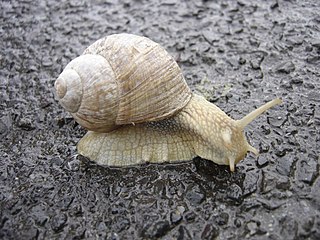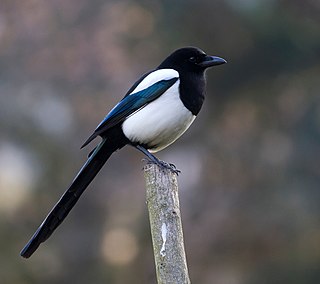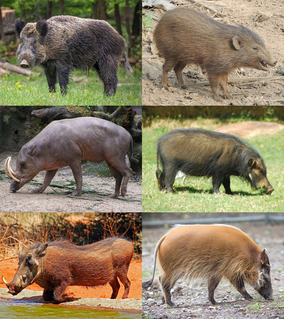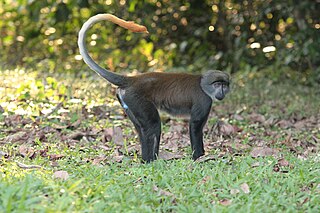
A chordate is an animal of the phylum Chordata. All chordates possess five synapomorphies, or primary characteristics, at some point during their larval or adulthood stages that distinguish them from all other taxa. These five synapomorphies include a notochord, dorsal hollow nerve cord, endostyle or thyroid, pharyngeal slits, and a post-anal tail. The name “chordate” comes from the first of these synapomorphies, the notochord, which plays a significant role in chordate structure and movement. Chordates are also bilaterally symmetric, have a coelom, possess a circulatory system, and exhibit metameric segmentation.

A snail is, in loose terms, a shelled gastropod. The name is most often applied to land snails, terrestrial pulmonate gastropod molluscs. However, the common name snail is also used for most of the members of the molluscan class Gastropoda that have a coiled shell that is large enough for the animal to retract completely into. When the word "snail" is used in this most general sense, it includes not just land snails but also numerous species of sea snails and freshwater snails. Gastropods that naturally lack a shell, or have only an internal shell, are mostly called slugs, and land snails that have only a very small shell are often called semi-slugs.

Zalophus is a genus of the family Otariidae of the order Carnivora.

Magpies are birds of the Corvidae family. Like other members of their family, they are widely considered to be intelligent creatures. The Eurasian magpie, for instance, is thought to rank among the world's most intelligent creatures, and is one of the few non-mammal species able to recognize itself in a mirror test. They are particularly well known for their songs and were once popular as cagebirds. In addition to other members of the genus Pica, corvids considered as magpies are in the genera Cissa, Urocissa, and Cyanopica.

Shrews are small mole-like mammals classified in the order Eulipotyphla. True shrews are not to be confused with treeshrews, otter shrews, elephant shrews, West Indies shrews, or marsupial shrews, which belong to different families or orders.

The Curculionidae are the family of the "true" weevils. They are one of the largest animal families, with 6,800 genera and 83,000 species described worldwide. They are the sister group to the family Brentidae.

The heterotrichs are a class of ciliates. They typically have a prominent adoral zone of membranelles circling the mouth, used in locomotion and feeding, and shorter cilia on the rest of the body. Many species are highly contractile, and are typically compressed or conical in form. These include some of the largest protozoa, such as Stentor and Spirostomum, as well as many brightly pigmented forms, such as certain Blepharisma.

Hermit crabs are anomuran decapod crustaceans of the superfamily Paguroidea that have adapted to occupy empty scavenged mollusc shells to protect their fragile exoskeletons. There are over 800 species of hermit crab, most of which possess an asymmetric abdomen concealed by a snug-fitting shell. Hermit crabs' soft (non-calcified) abdominal exoskeleton means they must occupy shelter produced by other organisms or risk being defenseless.

Suidae is a family of artiodactyl mammals which are commonly called pigs, hogs, or boars. In addition to numerous fossil species, 18 extant species are currently recognized, classified into between four and eight genera. Within this family, the genus Sus includes the domestic pig, Sus scrofa domesticus or Sus domesticus, and many species of wild pig from Europe to the Pacific. Other genera include babirusas and warthogs. All suids, or swine, are native to the Old World, ranging from Asia to Europe and Africa.

The sun-tailed monkey from Gabon is one of the least studied primates in its habitat. It was discovered as a new species in 1988, and is classified as a guenon, which is a member of the genus Cercopithecus, but was subsequently moved to the genus Allochrocebus. It is closely related to A. preussi and A. Ihoesti, which has been determined by chromosomal analysis. Sun-tailed monkeys prefer shady areas with dense vegetation. However, even after small amounts of logging activity, populations can be unaffected. Much of their diet remains unknown and is still being studied, but they are known to prefer fruit. Their social groups are made up of one male and multiple females. Generally, the sun-tailed monkey is less aggressive towards related individuals, which is noteworthy because it has been found that, in other primate species, aggression rates towards related individuals are generally as high or higher than aggression rates towards non-related individuals. Within their social groups, individual monkeys show preference for their mothers over their fathers, and are overall less aggressive to other monkeys that they are associated with spatially.

The Russian desman is a small semiaquatic mammal that inhabits the Volga, Don and Ural River basins in Russia, Ukraine and Kazakhstan. It constructs burrows into the banks of ponds and slow-moving streams, but prefers small, overgrown ponds with abundance of insects, crayfish and amphibians. The Russian desman often lives in small groups of two to five animals, and appears to have a complex communication and social system.

The Amur hedgehog, also called the Manchurian hedgehog, is a hedgehog similar to the European hedgehog in appearance and behaviour, although it is more lightly coloured. It is native to Amur Oblast and Primorye in Russia, Manchuria in China, and the Korean Peninsula. Like other hedgehogs, it uses scent and hearing while looking for prey, and the name "hedgehog" refers to the pig-like grunts it makes as it forages.

The Adelgidae are a small family of the Hemiptera closely related to the aphids, and often included in the Aphidoidea with the Phylloxeridae or placed within the superfamily Phylloxeroidea as a sister of the Aphidoidea within the infraorder Aphidomorpha. The family is composed of species associated with pine, spruce, or other conifers, known respectively as "pine aphids" or "spruce aphids". This family includes the former family Chermesidae, or "Chermidae", the name of which was declared invalid by the ICZN in 1955. There is still considerable debate as to the number of genera within the family, and the classification is still unstable and inconsistent among competing authors.

Jungia is a genus of flowering plants in the family Asteraceae. It is native mostly to South America, with one widespread species extending its range into Central America and southern Mexico.

Baird's shrew is a species of mammal in the family Soricidae. It is endemic to northwest Oregon. Baird's shrew inhabits moist conifer forests. Its fur is darker brown in winter than in summer, when it is brownish-chestnut or olive brown, with paler sides and belly. Males and females are about the same size, which is common among shrews in general. Also like other shrew species, Baird's shrew feeds on insects, worms, snails, and spiders. It shares the forests of its range with six other species of shrew, such as the Pacific shrew. Body length ranges from 100 to 143 mm, with an average weight of 7.6 g, but ranging anywhere from 5.5 to 11.2 g.

The masked flying fox, Moluccan masked flying fox or masked fruit bat, is a species of flying fox in the family Pteropodidae. It is endemic to Indonesia. It is part of a species complex of closely related species. The species is hunted.

The Mutisioideae are a subfamily in the plant family Asteraceae that includes about 630 species assigned to 44 different genera. This subfamily is mainly native in South America, except for Adenocaulon, Chaptalia, Gerbera, Trichocline, which have species in all continents other than Europe and Antarctica. Common characters are the deeply incised corollas of the disc florets, with five lobes, sometimes merged in two lips, flower heads with overlapping involucral bracts, anthers with tails and pointy tips, the styles usually stick far out of the florets and are essentially hairless. Most species are herbs, but some are vines, shrubs, or small trees.

Yurgovuchia is a genus of dromaeosaurid theropod dinosaurs that lived in North America during the Early Cretaceous period in what is now the Cedar Mountain Formation. It contains a single species, Yurgovuchia doellingi. The remains were discovered in Utah, United States.

The Nassauvieae are a tribe of flowering plants in the family Asteraceae.
Eumops wilsoni is a species of bat native to Ecuador and Peru. The bat has a distinct karyotype, sequence of the mitochondrial cytochrome-b gene, and other distinct genetic markers that distinguish it from closely related bats such as Eumops glaucinus and Eumops ferox. However, there are no morphological distinctions from those related species and thus there is uncertainty of its geographic distribution and population status, leading to its classification as "data deficient". Local threats to the bat's dry forest habitat further impede efforts to study the bats. Transition to farmland and urbanization threatens the dry forest habitat of the bat in the Andes. As an endemic species, the bat may be threatened by this habitat loss.



















